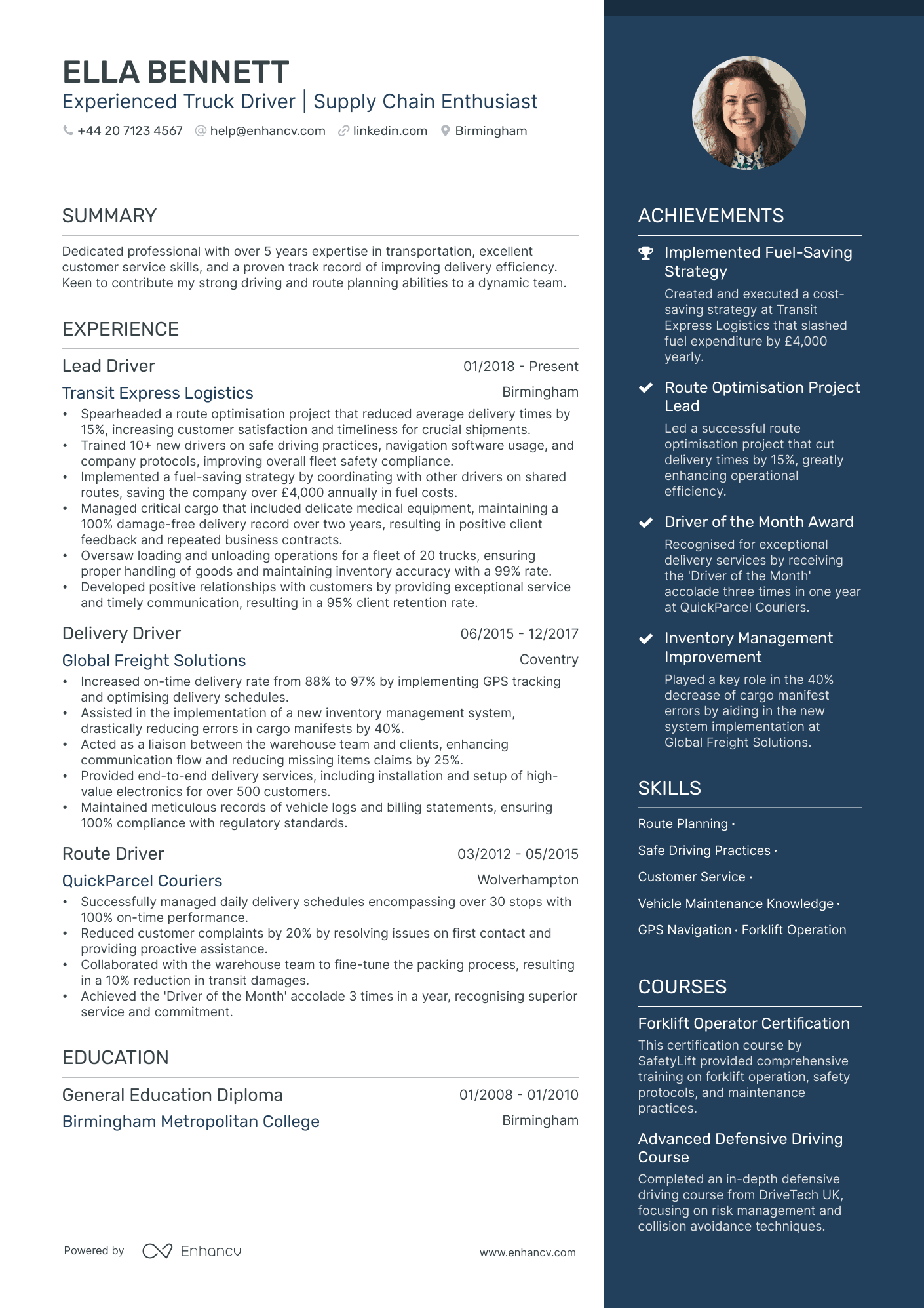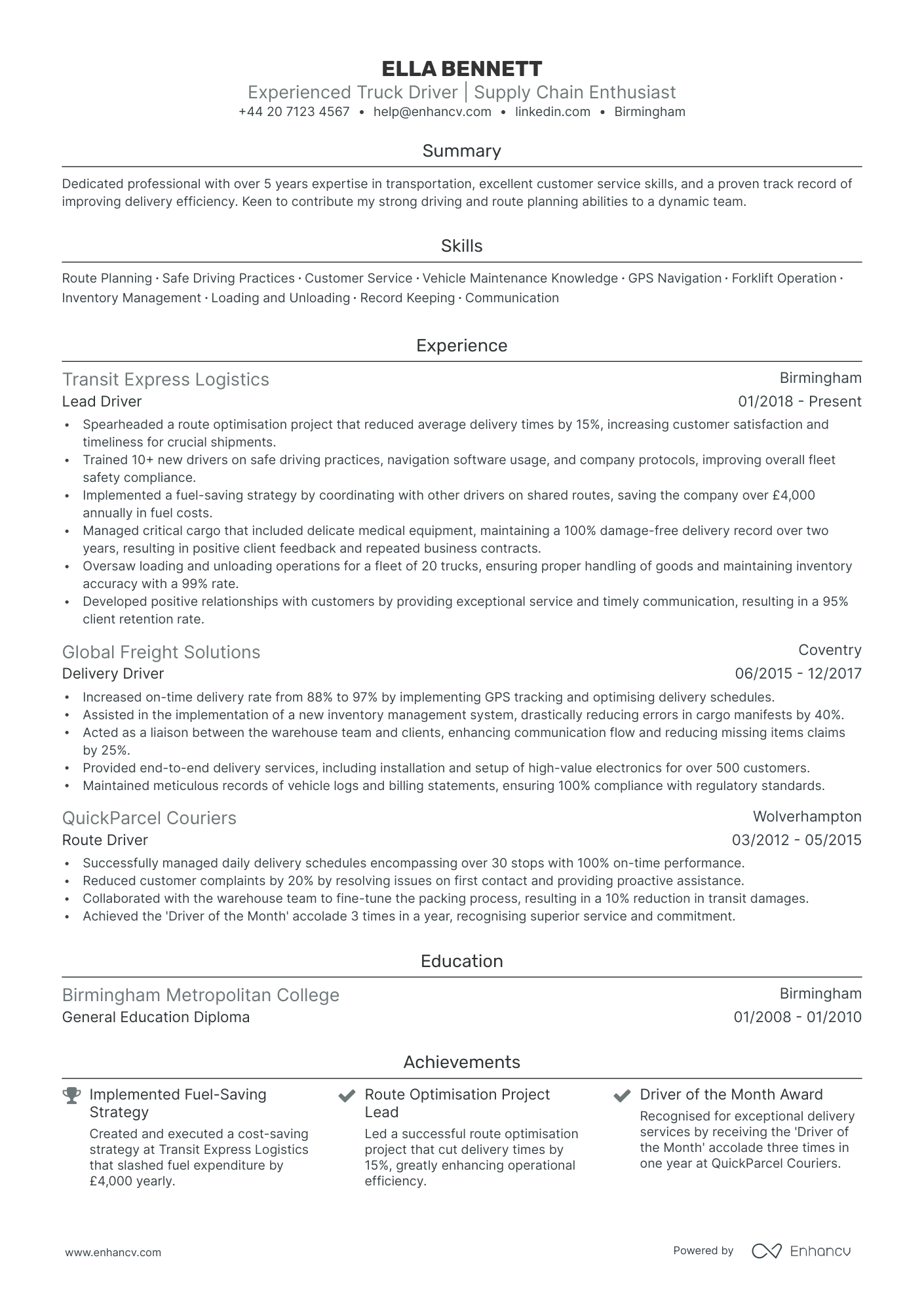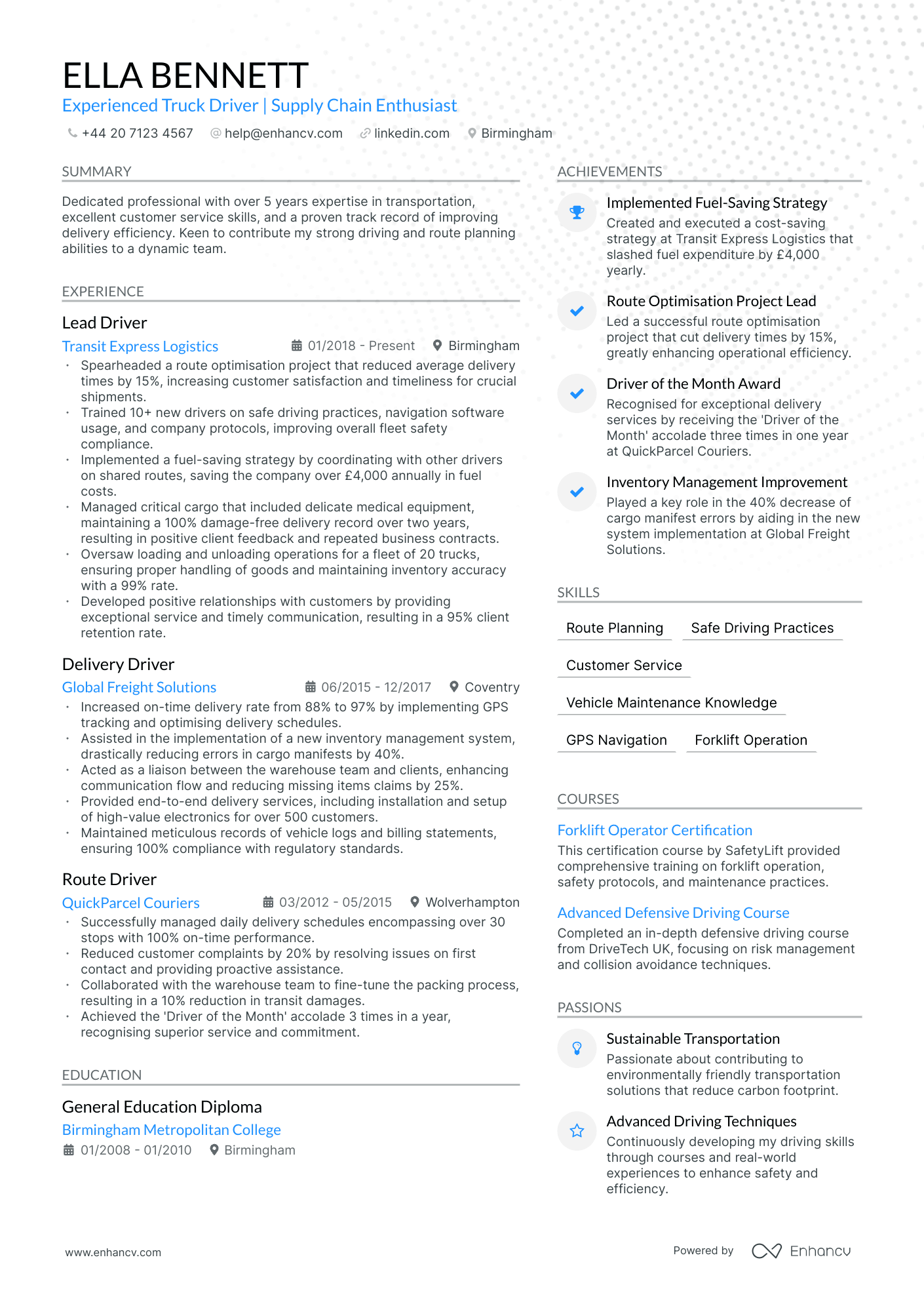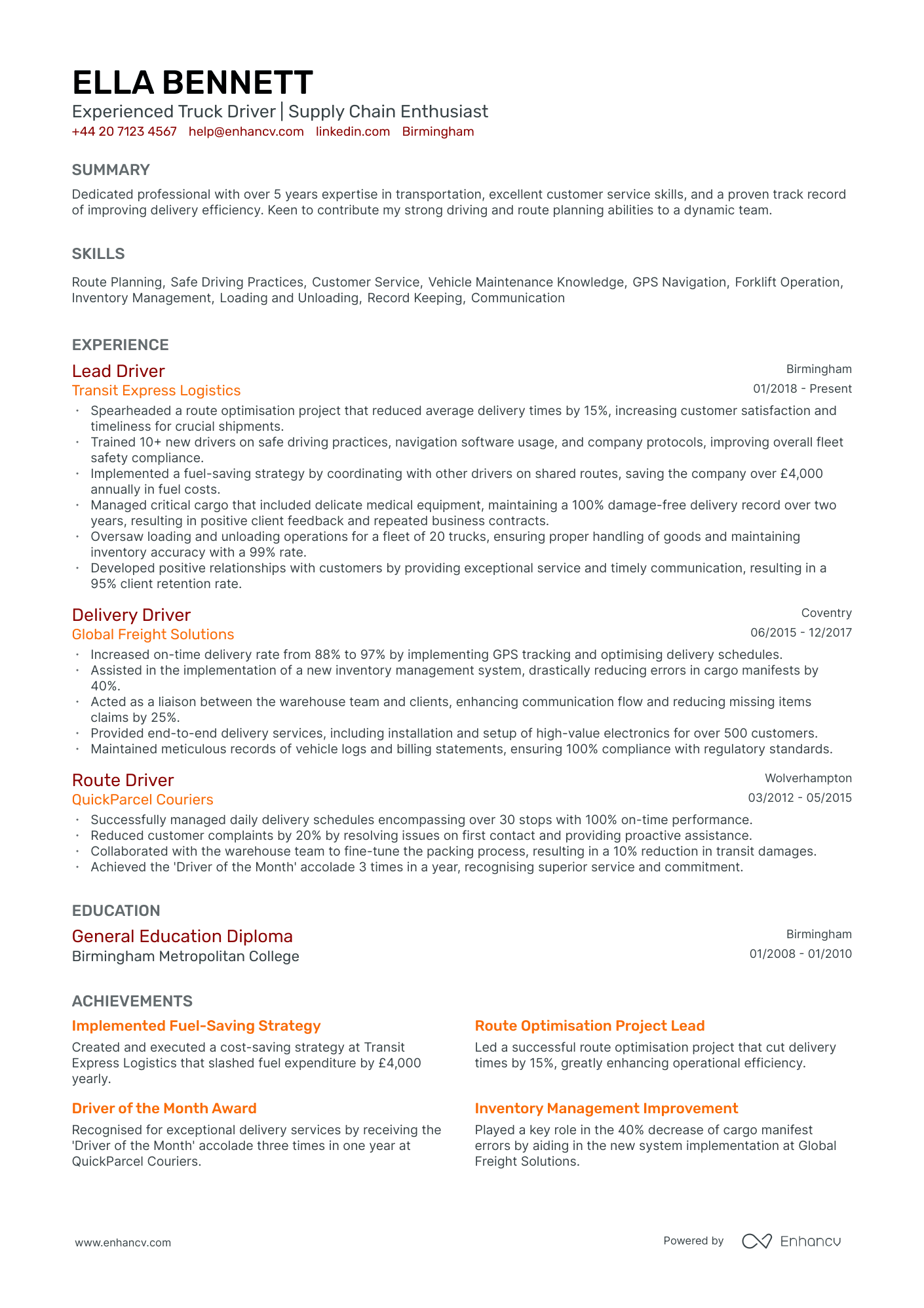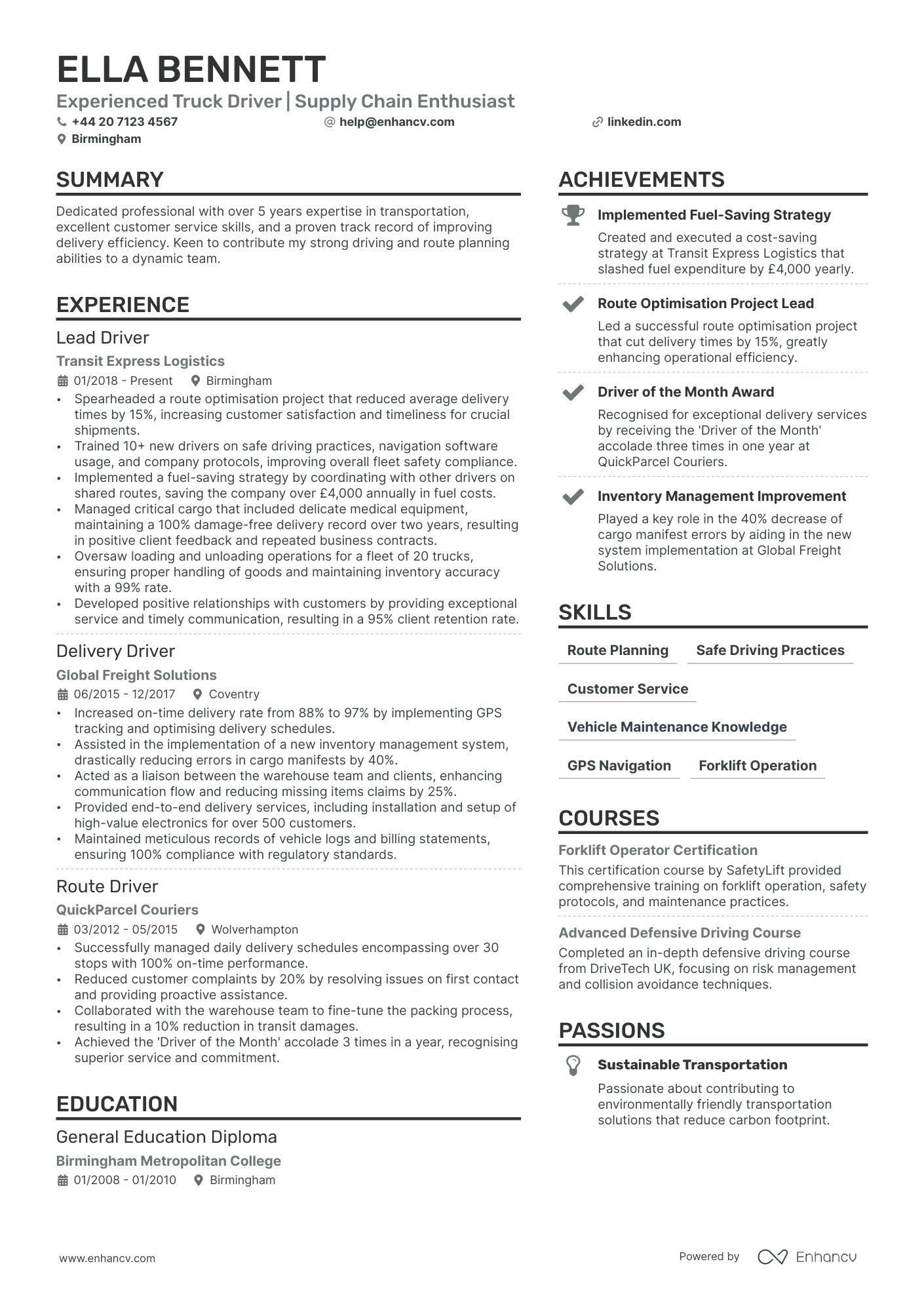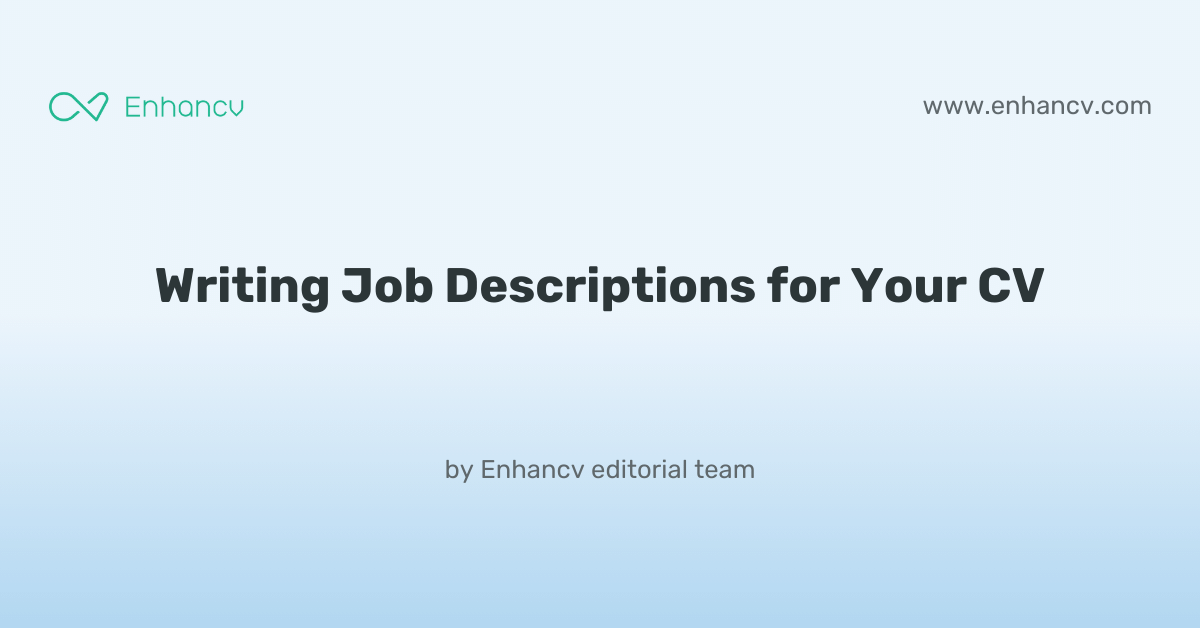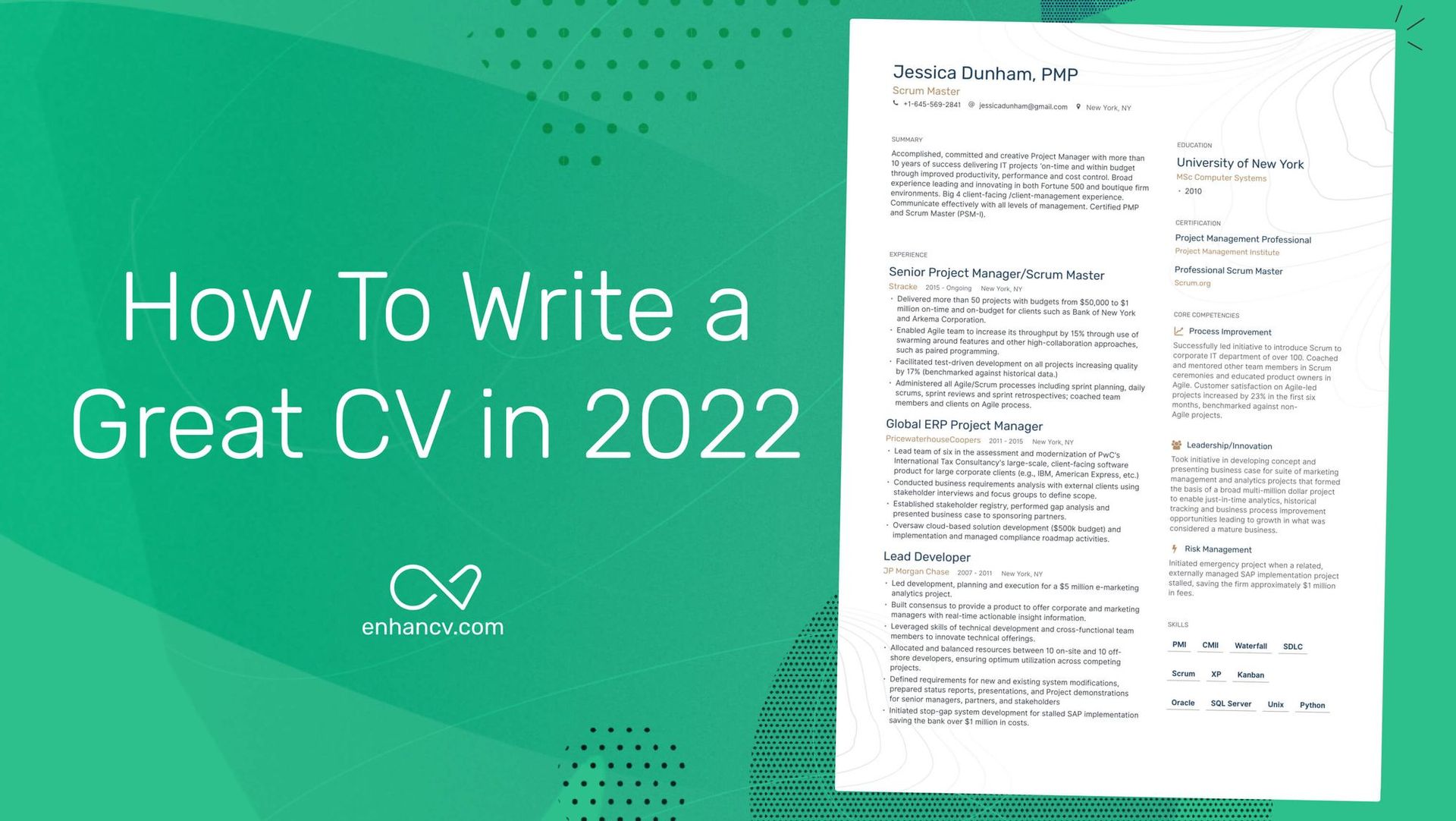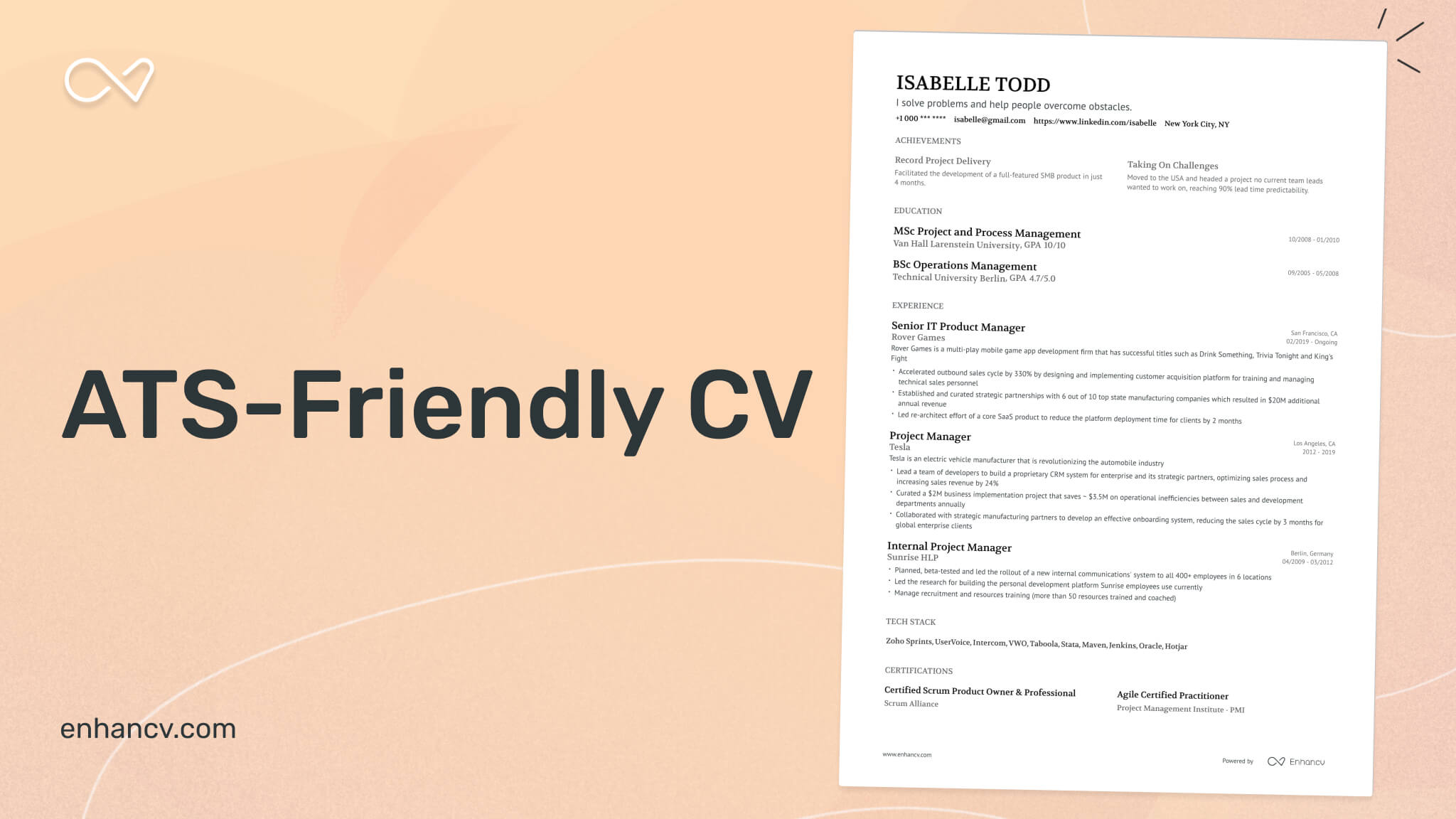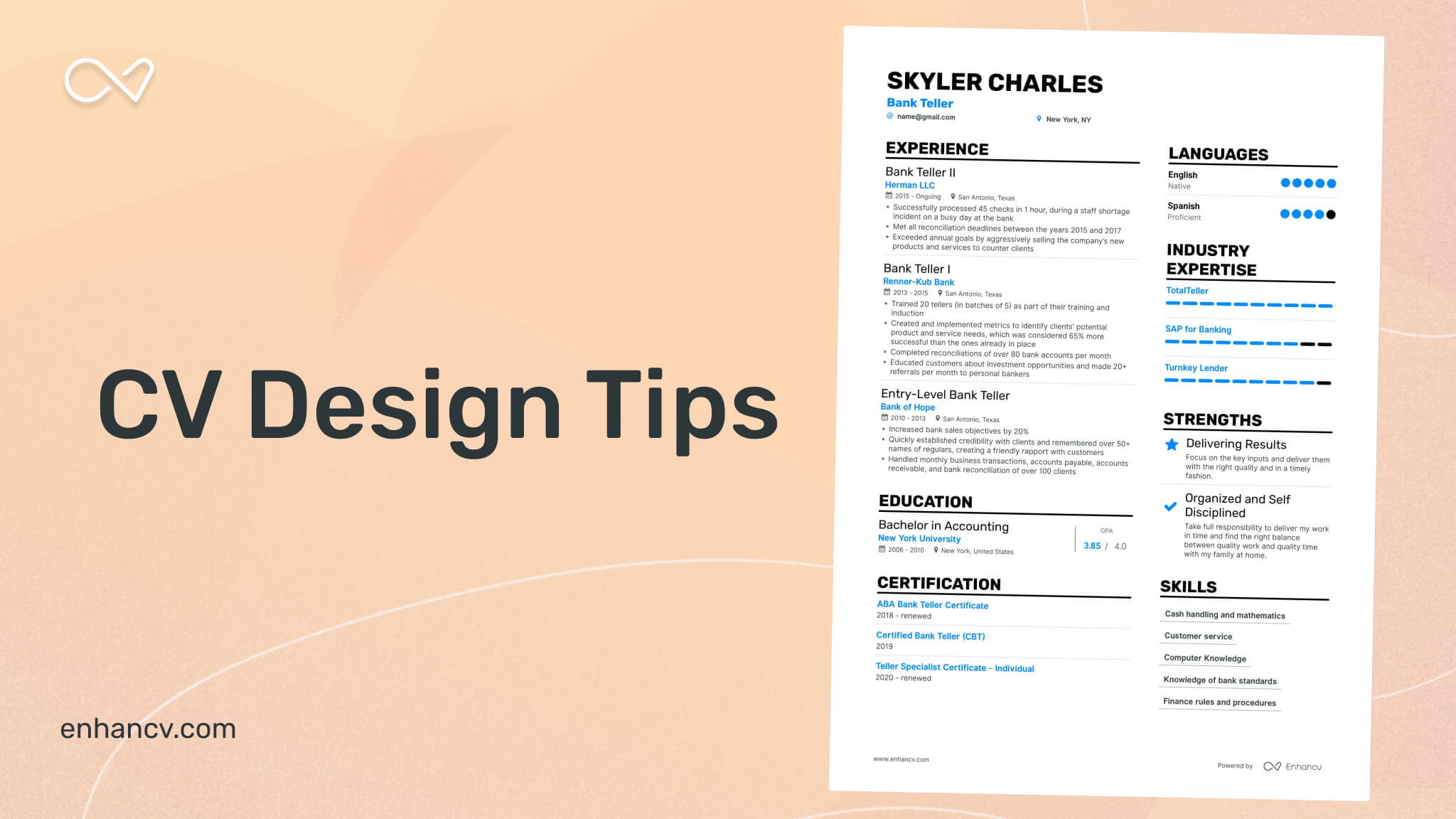Navigating through congested urban areas presents a complex CV challenge for you as a truck driver, often resulting in delays and increased stress. Our comprehensive guide offers strategic route planning tips and relaxation techniques to mitigate these challenges, ensuring a smoother journey.
- Applying the simplest CV design, so that recruiters can easily understand your expertise, skills, and professional background;
- Ensuring you stand out with your header, summary or objective statement, and a designated skills section;
- Creating your CV experience section - no matter how much expertise you have;
- Using real life professional CV examples to enhance the structure and outline of your profile.
If you still have no muse to write your professional CV, find some more industry-leading examples.
Structuring and formatting your truck driver CV for an excellent first impression
The experts' best advice regarding your CV format is to keep it simple and concise. Recruiters assessing your CV are foremost looking out for candidates who match their ideal job profile. Your white space, borders, and margins. You may still be wondering which format you need to export your CV in. We recommend using the PDF one, as, upon being uploaded, it never alters your information or CV design. Before we move on to the actual content of your truck driver CV, we'd like to remind you about the Applicant Tracker System (or the ATS). The ATS is a software that is sometimes used to initially assess your profile. Here's what you need to keep in mind about the ATS:- All serif and sans-serif fonts (e.g. Rubik, Volkhov, Exo 2 etc.) are ATS-friendly;
- Many candidates invest in Arial and Times New Roman, so avoid these fonts if you want your application to stand out;
- Both single and double column CVs can be read by the ATS, so it's entirely up to you to select your CV design.
PRO TIP
Be mindful of white space; too much can make the CV look sparse, too little can make it look cluttered. Strive for a balance that makes the document easy on the eyes.
The top sections on a truck driver CV
- Professional Summary highlights your driving expertise and quick decision-making abilities in logistics.
- Driving Experience showcases your years on the road and variety of vehicles handled.
- Licences and Certifications indicate your legal qualifications to operate different truck types.
- Safety Record demonstrates your commitment to maintaining impeccable driving standards.
- Route Knowledge emphasises your navigational skills and ability to plan efficient paths.
What recruiters value on your CV:
- Highlight your driving experience by including details on the types of vehicles you've operated and the conditions you've navigated, such as long-distance haulage, heavy loads, or adverse weather conditions.
- Emphasise safety records and any recognition you’ve received for safe driving, as this demonstrates your commitment to safe operation and reliability.
- Include any certifications or special licences you have, such as a Class 1 HGV licence, ADR, or CPC qualifications, which are essential for a professional truck driving career.
- Detail your knowledge of vehicle maintenance and your ability to perform pre- and post-trip inspections, as this shows you can be trusted to keep the vehicle in good condition.
- Mention your logistical skills, such as route planning and efficient loading methods, to illustrate your ability to deliver goods on time and in an organised manner.
Recommended reads:
What information should you include in your truck driver CV header?
The CV header is potentially the section that recruiters would refer to the most, as it should include your:
- Contact details - your professional (non-work) email address and phone number;
- Professional photograph - if you're applying hinting at the value you bring as a professional.
Many professionals often struggle with writing their truck driver CV headline. That's why in the next section of this guide, we've curated examples of how you can optimise this space to pass any form of assessment.
Examples of good CV headlines for truck driver:
- Senior HGV Driver | ADR Certified | Route Planning Expert | 10+ Years of Long-Haul Experience
- Class 1 HGV Driver | Clean Driving Record | Customer Service Focused | CPC Holder
- Seasoned LGV Driver | Heavy Load Specialist | Time-Sensitive Delivery Expert | 15 Years Experience
- Junior Delivery Driver | Van Operations | City & Rural Routes | Developing Haulage Skills
- Experienced Tanker Truck Driver | HazMat Qualified | Safety Compliance | 8 Years On The Road
- Professional Articulated Lorry Driver | International Routes | Multilingual | Efficient Logistics Management
Your truck driver CV introduction: selecting between a summary and an objective
truck driver candidates often wonder how to start writing their resumes. More specifically, how exactly can they use their opening statements to build a connection with recruiters, showcase their relevant skills, and spotlight job alignment. A tricky situation, we know. When crafting you truck driver CV select between:
- A summary - to show an overview of your career so far, including your most significant achievements.
- An objective - to show a conscise overview of your career dreams and aspirations.
Find out more examples and ultimately, decide which type of opening statement will fit your profile in the next section of our guide:
CV summaries for a truck driver job:
- Seasoned truck driver with 10 years of experience expertly navigating commercial vehicles, primarily focusing on transport for the construction industry in the Midlands. Recognised for the pivotal role in achieving a consistent on-time delivery record whilst maintaining strict adherence to safety protocols and vehicle maintenance schedules.
- Dedicated professional with over 8 years of long-haul trucking experience, possessing a strong knowledge of GPS route planning and freight logistics. Notable achievement includes receiving the 'Driver of the Year' award twice for exceptional customer service and cargo handling for a leading national logistics company.
- Former warehouse operations manager with extensive experience in logistics and supply chain seeking to bring organisational and time management skills to the trucking industry. Adept at coordinating transport schedules and workforce management, eager to apply these skills to a career on the open road.
- Career switcher with a background in customer service management, eager to leverage interpersonal skills and attention to detail in a truck driving career. Proven track record of managing high-volume customer interactions and operational troubleshooting, ready to adapt swiftly to new challenges presented by cross-country logistics.
- As an individual with a passion for the open road and a fresh Commercial Driver's License, my objective is to contribute to efficient transportation operations while acquiring practical expertise in vehicle handling and route management. Keen to uphold safety standards and become an asset to a seasoned fleet.
- Energetically pursuing a truck driving career with no prior experience but equipped with a brand-new HGV license and a profound dedication to learning. Eager to make a difference through punctual deliveries and committed to acquiring top-tier navigation and freight handling skills through diligent work and mentorship.
The best formula for your truck driver CV experience section
The CV experience section is the space where many candidates go wrong by merely listing their work history and duties. Don't do that. Instead, use the job description to better understand what matters most for the role and integrate these keywords across your CV. Thus, you should focus on:
- showcasing your accomplishments to hint that you're results-oriented;
- highlighting your skill set by integrating job keywords, technologies, and transferrable skills in your experience bullets;
- listing your roles in reverse chronological order, starting with the latest and most senior, to hint at how you have grown your career;
- featuring metrics, in the form of percentage, numbers, etc. to make your success more tangible.
When writing each experience bullet, start with a strong, actionable verb, then follow it up with a skill, accomplishment, or metric. Use these professional examples to perfect your CV experience section:
Best practices for your CV's work experience section
- Expertly navigated various truck models, ensuring timely delivery of goods across extensive road networks throughout the UK and Europe.
- Maintained a clean driving record, demonstrating consistent adherence to traffic laws and regulations to promote road safety.
- Conducted routine vehicle checks and maintenance, guaranteeing that the truck met all safety standards and operational requirements.
- Efficiently managed delivery schedules and route planning, optimising travel times and reducing fuel consumption.
- Handled the loading and unloading of cargo with care, employing proper safety protocols to secure goods and prevent damage during transit.
- Provided excellent customer service, establishing positive relationships with clients during pick-up and delivery processes.
- Completed detailed logs and reports for each trip, ensuring accurate tracking of hours, distances covered, and fuel usage.
- Adapted to varying weather conditions and unforeseen road events, displaying decision-making skills and ensuring continuity of service.
- Enhanced security measures by adhering to company policies regarding the transport of hazardous materials and high-value goods.
- Safely transported goods across the US, maintaining a 99% on-time delivery record over a 5-year period.
- Managed strict schedules and planned optimal routes for long-haul deliveries, reducing fuel consumption by 10% annually.
- Maintained detailed logs in accordance with federal DOT regulations and company policies, achieving a flawless audit record.
- Operated heavy trucks with a focus on safety, which reduced accidents by 25% during tenure.
- Provided core training to 20 new drivers, focusing on navigation, compliance, and efficiency techniques.
- Coordinated with warehouse operations to ensure proper loading of hazardous materials, ensuring 100% legal compliance.
- Led a team of drivers in a fast-paced distribution environment, efficiently managed time-sensitive cargo deliveries.
- Implemented a driver mentorship program, which improved new driver retention by 30%.
- Streamlined route planning using advanced GPS technology, leading to a 15% reduction in average delivery times.
- Handled specialized freight and oversized loads, completing over 500 successful transports without incident.
- Assisted in the development of a fuel-saving strategy that resulted in an annual cost savings of $50,000.
- Conducted regular vehicle inspections and minor repairs, keeping equipment in top condition and avoiding potential delays.
- Serviced a regular clientele of five major businesses, fostering strong partnerships through consistent and reliable delivery performance.
- Trained on electronic logging devices (ELDs) to ensure accurate and compliant tracking of hours-of-service (HOS), resulting in zero violations.
- Participated in the pilot program for eco-friendly vehicles, contributing to company recognition for environmental responsibility.
- Efficiently managed a fleet of refrigerated trucks, delivering perishable goods with a 99.5% success rate.
- Negotiated with vendors to improve loading times, which increased daily deliveries by 15%.
- Acted as a liaison between customers and company dispatch, resolving issues swiftly and to mutual satisfaction.
- Diligently followed industry standards and company procedures for transporting hazardous materials, maintaining a perfect safety record.
- Enhanced the efficiency of intermodal transport operations for the company, leading to a 20% increase in on-time container deliveries.
- Collaborated with logistics coordinators to improve supply chain strategies, which streamlined delivery processes.
- Expertly navigated dense urban environments to ensure timely local deliveries, surpassing the company average for time efficiency by 12%.
- Participated in seasonal delivery projects, successfully managing up to a 30% increase in workload during peak periods.
- Assessed and reported vehicle maintenance needs, contributing to a decrease in average repair costs by 17%.
- Operated a tanker truck for liquid transport, achieving a zero-accident rate throughout tenure with focus on defensive driving practices.
- Engaged in cross-training initiatives, enhancing flexibility and support across various transport modes.
- Successfully adopted new regulatory compliance software, which improved the accuracy of record-keeping.
- Maintained exemplary driving record over long-haul routes, covering an average of 100,000 miles per year.
- Facilitated in implementing a dynamic routing software that improved real-time decision making for route adjustments.
- Consistently met customer demands by providing flexible scheduling options, leading to a 25% increase in customer satisfaction scores.
Lacking professional expertise: how to write your CV to highlight your best talents
Don't count on your lucky stars when you're applying for a role, where you happen to have less (or almost none) professional experience. Recruiters sometimes do hire inexperienced candidates if they're able to present their unique value from the get-go. So, instead of opting for the traditional, CV experience section:
- List any applicable expertise you happen to have - no matter if it's a part-time job, internship, or volunteer work. This would hint to recruiters that your profile is relevant;
- Focus your CV on your transferrable skills or talents you've obtained thanks to your whole life and work experience. In effect, you'll be spotlighting your value as a candidate;
- Separate more space for your applicable academic background and certificates to show you have the technical know-how;
- Ensure that within your objective, you've defined why you'll like the job and how you'll be the perfect match for it. Always ensure you've tailored your CV to individual applications.
Looking for more good examples for your first job? We'll show you how other candidates, with less professional experience, have created their job-winning CVs.
Recommended reads:
PRO TIP
If you have experience in diverse fields, highlight how this has broadened your perspective and skill set, making you a more versatile candidate.
The CV skills' divide: between hard and soft skills
Of course, you may have read the job requirements plenty of times now, but it's key to note that there is a difference between technical and personal skills. Both are equally relevant to your job application. When writing about your skill set, ensure you've copy-pasted the precise skill from the job requirement. This would not only help you ensure you have the correct spelling, but also pass any Applicant Tracker System (ATS) assessments.
- Hard skills show your technological capabilities. Or whether you'll be a good technical fit to the organisation. Ensure you've spotlighted your hard skills in various sections of your CV (e.g. skills section, projects, experience) by including the technology and what you've attained;
- Soft skills pinpoint your personality and people or communication skills, hinting at if you'll easily accomodate into the team or organisation. Quantify your soft skills in your CV achievements, strengths, summary/objective, and experience sections. Always support your soft skills with how they've helped you grow as a professional.
Top skills for your truck driver CV:
Commercial Driving
GPS and Route Planning
Vehicle Maintenance
Safety Regulations Compliance
Cargo Handling
Time Management
Mechanical Knowledge
Electronic Logging Devices
Hazardous Materials Handling
Load Securing
Reliability
Attention to Detail
Stress Management
Communication
Problem-Solving
Adaptability
Customer Service
Decision Making
Teamwork
Patience
PRO TIP
If you have received professional endorsements or recommendations for certain skills, especially on platforms like LinkedIn, mention these to add credibility.
CV education and certificates: your academic background as proof of your skill set
A common misconception about your truck driver CV education is that you only need it, if you have less professional experience. That is completely false. The CV education section serves to back up your technical (and sometimes personal) capabilities, fill in gaps in your work history, and show you have the initial industry background and know-how. When creating your education section:
- List your degrees in the reverse chronological order, starting with the most recent (and relevant) ones first;
- Include your degree and university names, start and graduation dates. It's optional to also denote you received a "First-Class Honours" for diplomas that are more relevant to the role;
- Curate your relevant university coursework, projects, or thesis work if you happen to have less professional expertise and need to integrate more job keywords and skills.
Your professional qualifications don't need to stop at your academic background. It's advisable to also select up to three of your most noteworthy (and relevant) industry certificates and feature them in a dedicated section. Once more, include the certificate name, the institution that issued it out, and the date you obtained it on. You could feature both hard skills and soft skills certificates, as in the examples below:
PRO TIP
If there's a noticeable gap in your skillset for the role you're applying for, mention any steps you're taking to acquire these skills, such as online courses or self-study.
Recommended reads:
Key takeaways
Write your professional truck driver CV by studying and understanding what the role expectations are. You should next:
- Focus on tailoring your content to answer specific requirements by integrating advert keywords through various CV sections;
- Balance your technical know-how with your personal skills to showcase what the unique value would be of working with you;
- Ensure your CV grammar and spelling (especially of your key information and contact details) is correct;
- Write a CV summary, if your experience is relevant, and an objective, if your career ambitions are more impressive;
- Use active language by including strong, action verbs across your experience, summary/objective, achievements sections.
